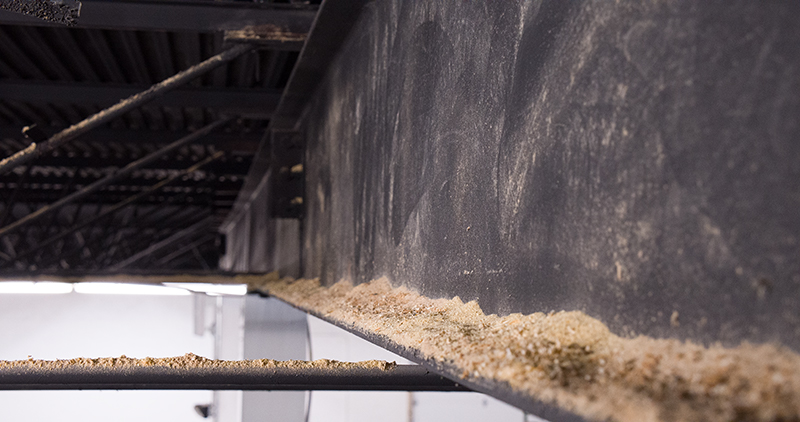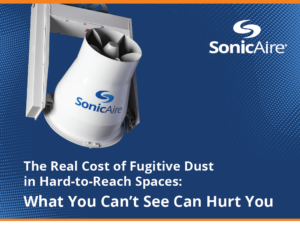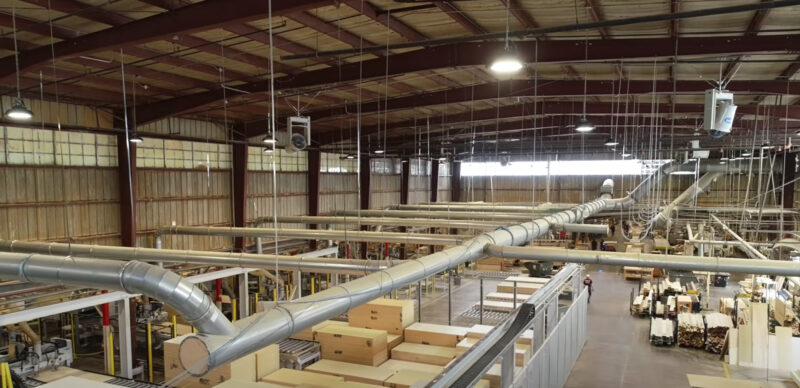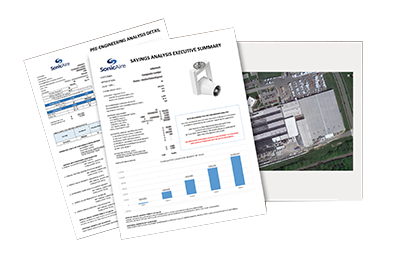You may already have an excellent filtration system with a robust dust collector at your facility. You spent tens of thousands of dollars on it, in fact. Whether you work with wood, paper, non-wovens, plastics, or grain, there’s a collection system that’s best suited for your industry.
So, why are you still seeing dust build up overhead?
The Hard Truth
Your filtration system is working, but you’ll likely produce far more dust than most filtration systems are capable of capturing. A good policy is to capture all the dust you can. Unfortunately, that’s often determined by how much you can afford. Bigger, more complex systems may capture more, but that doesn’t mean they’re affordable. Depending on your industry and need, a typical filtration system often runs between $20,000 to $500,000. But even if you do spend half a million dollars for the best of the best, you’ll still struggle to capture all the dust in your facility. It’s a hard pill to swallow.
Your filtration system will never be 100% effective. There will always be fugitive dust.
Out of Sight, Out of Mind?
You may not see dust buildup, and your employees may not either, but it’s still there. Above your hoods, on your air ducts, and in your rafters – your filtration system can’t handle all the dust your facility produces, and it will build up in places you can’t reach.

With the right filtration system, dust will probably build up slightly slower, but look for that to be a declining trend. Over time, you’ll notice dust buildup in those tough-to-reach places, even from floor level.
Even if you aren’t looking for hidden dust, you can trust OSHA will be. If it’s there, an OSHA inspector is sure to find it.
Dust Collection Helps! – But Not Enough.
Reading this may leave you scratching your head. After all, you’ll probably notice a drastic improvement in the attention necessary to keep your facility clean after installing a quality dust collection and filtration system. You may even think that annual cleaning companies coming in to vacuum your rafters is a thing of the past.
But it isn’t.
The money you spend on your filtration system isn’t where your facility’s dust management expense ends. You’ll still need to spend money on a cleaning crew, or if you decide to handle it in-house, you’ll be paying your production team to cease production to vacuum your ceiling areas.
What’s Keeping the Filtration from Being Enough?
So after the significant investment you’ve made in your filtration system, you’ll likely wonder why it isn’t enough to eliminate the dust buildup problem. You’re probably experiencing a combination of four issues that prevent your filtration system from doing it all.
If you’re interested in hearing what our Chief Operating Officer, Jordan Newton, P.E. has to say on these and more, check out our You Ask. We Answer.
The Real Cost of Manual Dust Cleaning
It isn’t until you sit down and start adding up all of the costs the problem becomes apparent.
Filter Media Blinding
Collection Point Problems
Your facility isn’t a perfect air-tight bubble, and neither is your filtration system. Even the best systems will still not capture 100% of the dust; some will inevitably escape into your work environment. It’s simply unavoidable. You may not think this is enough to cause buildup, but it is, and it will. Remember, too, that high-efficiency machines are moving faster than ever – which is great news in terms of production, but an increase in productivity comes with an increase in fugitive dust.
Facility Changes
When your filtration system is installed at the perfect spot to catch dust from your primary production line, you’ll feel confident that you’re doing everything you can for dust management. A specialist may have even plotted where your filtration system should go to get the most bang for your buck. But even if your filtration system could eliminate all the dust your facility produces, your business isn’t stagnant.
Dust Clings
This point may seem obvious, but it’s still crucial to understand the shortcomings of your filtration system. If airborne dust emitted from production migrates to any product or material in your facility, it will cling. Before you know it, the dust you wanted your filtration system to eliminate is spread all over your facility. Movement and natural air currents (including thermal currents) carry that fugitive dust into your rafters and ceiling areas. These scenarios show why your filtration system isn’t managing your dust single-handedly, but you can easily summarize them with one bold statement.
Your filtration system just isn’t meant to do it all alone.
Your Filtration System Wasn’t a Waste of Money!
After learning its limits, maybe you’re feeling disappointed with your purchase of your dust filtration system. But it still serves an important purpose in your facility, too. Every speck of dust collected by your filtration system is one that doesn’t accumulate in your ceiling area.
The air is still circulated through your facility, and you’ll still see the heat exhausted outdoors in those hot summer months. You will still need to find a way to clean the build up that occurs, but it will happen more slowly than it would without a filtration system.
Fortunately, there is a way to get a better result for dust management.
Filtrations Systems Work Best in Tandem with a Fan System
A filtration system with a robust dust collector will still gather dust from your facility. That’s what it’s for – it’s right there in the name, after all! But if you want to optimally manage dust in your facility, it’s probably time to call for backup.
If you want to do more than merely slow dust accumulation, then you’ll need something to work in tandem with your filtration system.
Enter SonicAire Dust Control Fans.
SonicAire Dust Control Fans and Dust Collection Systems are the perfect 1-2 Punch
SonicAire Dust Control Fans create a powerful air barrier in your facility to disrupt the thermal currents that carry dust into your rafters and overhead spaces. The fans rotate and oscillate to ensure that dust particles do not travel where they can’t be reached. Your filtration system will gather what it can, and the rest will fall to the floors, easily swept up by employees as part of the daily housekeeping of any facility.
Without SonicAire fans creating that air barrier for dust, you’ll still need to perform regular and costly dust clean-up.
Best-case scenario? You already have a safe way to get to your rafters, and you have the manpower and equipment on hand to clean it yourself. You have a newer filtration system, and you have the time to clean the filters regularly. Even in this rare, perfect set of circumstances, you still need to slow or even stop production for your team members to divert to their new temporary job of dust management. And that’s probably not great for morale, either.
Of course, your business doesn’t operate on ideals alone.
So what’s the worst-case scenario? You have an older filtration system that needs maintenance. You have to replace a costly filter more often than recommended, and it still doesn’t collect as much dust as it once did. So you’ll need to clean your rafters and ceiling areas at least twice a year. You don’t have extra equipment to do the job properly, so you have to hire a cleaning crew. That service can run over $8,000 per visit.
The crew also needs access to your ceiling, and if you can’t reach it all with lifts and vacuums, you may even need to construct pathways for them to reach where dust has accumulated. You would have to stop production so your employees can build walkways in the rafters and then for the cleaning crew to do their job.
All said, you’ll probably have a handful of days per year where your factory doesn’t operate at all due to cleaning.
Dust is often discussed as a significant risk for both safety and OSHA citations. But don’t forget how hard the additional costs will hit your bottom line if you do dust management by only halves. SonicAire’s fans will take your company from halfway there on dust management to guaranteed full compliance.
SonicAire fans eliminate the need for all of these profit-eating vampires and allow you to achieve clean ceilings without micromanagement. And you’ll greatly appreciate the assurance you get with SonicAire’s compliance guarantee.
If you’re interested in seeing how SonicAire can improve your facility’s filtration system, click here for a Complimentary Dust Management Plan and ROI Analysis.
If your facility could use a better way to control dust, click here to request a Complimentary Dust Management Plan and ROI Analysis. Getting ahead of the problem may qualify your company for more insurance options and better coverage.
SonicAire Fans – A Cost-Effective Alternative
We’re not going to lie to you. Installing a SonicAire Dust Control Fan System requires an investment. There are very few facilities that can get by with a couple of fans. But the long-term benefits speak for themselves.
SonicAire fans either run for specified periods during the day or all day, depending upon your operations and dust production level. However, they use two different tactics to prevent combustible dust buildup in overhead areas.
First, they clean off higher surfaces with continual airflow. This prevents buildup and eliminates the cleaning of these areas. Second, a properly engineered system creates an Air Barrier to prevent warm air currents from bringing dust up into overhead spaces.
Let’s look at how they impact the costs we’ve highlighted above.
Measuring the Difference
Each facility is different. In manufacturing and processing, operations produce varying levels and types of fugitive dust. But each facility is likely overspending on manual cleaning or simply not cleaning enough.
When you consider the labor, equipment, and lost productivity that goes into manual cleaning practices and then add in the insurance costs, potential fines, and employee dissatisfaction. Is manually cleaning your facility really saving you money?
We’re confident our combustible dust control systems will save your facility money even with the initial investment to purchase and install. But, if you’re not 100% sold, we get it. That’s why we offer free dust management plans with ROI Analysis. These engineered plans recommend the amount and placing of fans to ensure maximum protection from dust buildup.
Click here to request your Free Dust Management Plan.
Or contact us to discuss dust control solutions for your facility.
You may already have an excellent filtration system with a robust dust collector at your facility. You spent tens of thousands of dollars on it, in fact. Whether you work with wood, paper, non-wovens, plastics, or grain, there’s a collection system that’s best suited for your industry.
So, why are you still seeing dust build up overhead?
The Hard Truth
Your filtration system is working, but you’ll likely produce far more dust than most filtration systems are capable of capturing. A good policy is to capture all the dust you can. Unfortunately, that’s often determined by how much you can afford. Bigger, more complex systems may capture more, but that doesn’t mean they’re affordable. Depending on your industry and need, a typical filtration system often runs between $20,000 to $500,000. But even if you do spend half a million dollars for the best of the best, you’ll still struggle to capture all the dust in your facility. It’s a hard pill to swallow.
Your filtration system will never be 100% effective. There will always be fugitive dust.
Out of Sight, Out of Mind?
You may not see dust buildup, and your employees may not either, but it’s still there. Above your hoods, on your air ducts, and in your rafters – your filtration system can’t handle all the dust your facility produces, and it will build up in places you can’t reach.

With the right filtration system, dust will probably build up slightly slower, but look for that to be a declining trend. Over time, you’ll notice dust buildup in those tough-to-reach places, even from floor level. Even if you aren’t looking for hidden dust, you can trust OSHA will be. If it’s there, an OSHA inspector is sure to find it.
It Helps! – But Not Enough.
Reading this may leave you scratching your head. After all, you’ll probably notice a drastic improvement in the attention necessary to keep your facility clean after installing a quality dust collection and filtration system. You may even think that annual cleaning companies coming in to vacuum your rafters is a thing of the past.
But it isn’t.
The money you spend on your filtration system isn’t where your facility’s dust management expense ends. You’ll still need to spend money on a cleaning crew, or if you decide to handle it in-house, you’ll be paying your production team to cease production to vacuum your ceiling areas.
What’s Keeping the Filtration from Being Enough?
So after the significant investment you’ve made in your filtration system, you’ll likely wonder why it isn’t enough to eliminate the dust buildup problem. You’re probably experiencing a combination of four issues that prevent your filtration system from doing it all.
Filter Media Blinding
The filter in your system has pores that allow air to travel through. Over time, those pores begin clogging, also known as “blinding.” As they clog, the suction weakens, and it captures less dust. Filters all require some type of maintenance; depending on your system, you’ll either need to clean or replace them regularly.
Both of these require time and money – and when you’re operating a business, preventative maintenance can slip as a priority. It doesn’t make you money, and it’s all too easy to delay. That means that your filtration system won’t always give you the same results that you saw when you first installed it.
Every day it operates, your filter performance declines.
Collection Point Problems
Your facility isn’t a perfect air-tight bubble, and neither is your filtration system. Even the best systems will still not capture 100% of the dust; some will inevitably escape into your work environment. It’s simply unavoidable. You may not think this is enough to cause buildup, but it is, and it will.
Remember, too, that high-efficiency machines are moving faster than ever – which is great news in terms of production, but an increase in productivity comes with an increase in fugitive dust.
Facility Changes
When your filtration system is installed at the perfect spot to catch dust from your primary production line, you’ll feel confident that you’re doing everything you can for dust management. A specialist may have even plotted where your filtration system should go to get the most bang for your buck. But even if your filtration system could eliminate all the dust your facility produces, your business isn’t stagnant.
As your business grows and changes, so does your floor plan. Production lines get relocated, old equipment breaks, and new equipment is purchased. These changes should alter the length and design of ductwork, but rarely does a factory go back to the drawing board every time they rearrange equipment. Keeping the ductwork the same, despite changes, decreases air volume at each collection point. With modifications, you won’t have the same airflow that you once did at the time of installation. If you move or add equipment, you should consider the impact on your filtration system.
Dust Clings
This point may seem obvious, but it’s still crucial to understand the shortcomings of your filtration system. If airborne dust emitted from production migrates to any product or material in your facility, it will cling. Before you know it, the dust you wanted your filtration system to eliminate is spread all over your facility. Movement and natural air currents (including thermal currents) pull that fugitive dust off clothes and carry it into your rafters and ceiling areas.
These scenarios show why your filtration system isn’t managing your dust single-handedly, but you can easily summarize them with one bold statement.
Your filtration system just isn’t meant to do it all alone.
The Real Cost of Manual Dust Cleaning
It isn’t until you sit down and start adding up all of the costs the problem becomes apparent.
SonicAire Fans – A Cost-Effective Alternative
We’re not going to lie to you. Installing a SonicAire Dust Control Fan System requires an investment. There are very few facilities that can get by with a couple of fans. But the long-term benefits speak for themselves.
SonicAire fans either run for specified periods during the day or all day, depending upon your operations and dust production level. However, they use two different tactics to prevent combustible dust buildup in overhead areas.
First, they clean off higher surfaces with continual airflow. This prevents buildup and eliminates the cleaning of these areas. Second, a properly engineered system creates an Air Barrier to prevent warm air currents from bringing dust up into overhead spaces.
Let’s look at how they impact the costs we’ve highlighted above.
Your Filtration System Wasn’t a Waste of Money!
After learning its limits, maybe you’re feeling disappointed with your purchase of your dust filtration system. But it still serves an important purpose in your facility, too. Every speck of dust collected by your filtration system is one that doesn’t accumulate in your ceiling area.
The air is still circulated through your facility, and you’ll still see the heat exhausted outdoors in those hot summer months. You will still need to find a way to clean the build up that occurs, but it will happen more slowly than it would without a filtration system.
Fortunately, there is a way to get a better result for dust management.
Filtrations Systems Work Best in Tandem with a Fan System
A filtration system with a robust dust collector will still gather dust from your facility. That’s what it’s for – it’s right there in the name, after all! But if you want to optimally manage dust in your facility, it’s probably time to call for backup. If you want to do more than merely slow dust accumulation, then you’ll need something to work in tandem with your filtration system.
Enter SonicAire Dust Control Fans.
SonicAire Dust Control Fans and Dust Collection Systems are the perfect 1-2 Punch
SonicAire Dust Control Fans create a powerful air barrier in your facility to disrupt the thermal currents that carry dust into your rafters and overhead spaces. The fans rotate and oscillate to ensure that dust particles do not travel where they can’t be reached. Your filtration system will gather what it can, and the rest will fall to the floors, easily swept up by employees as part of the daily housekeeping of any facility.
If you’re interested in learning more, check out our Chief Operating Officer, Jordan Newton, in YAWA: Fans vs. Filtration
Without SonicAire fans creating that air barrier for dust, you’ll still need to perform regular and costly dust clean-up.
Best-case scenario? You already have a safe way to get to your rafters, and you have the manpower and equipment on hand to clean it yourself. You have a newer filtration system, and you have the time to clean the filters regularly. Even in this rare, perfect set of circumstances, you still need to slow or even stop production for your team members to divert to their new temporary job of dust management. And that’s probably not great for morale, either.
Of course, business doesn’t operate only on ideals.
So what’s the worst-case scenario? You have an older filtration system that needs maintenance. You have to replace a costly filter more often than recommended, and it still doesn’t collect as much dust as it once did. So you’ll need to clean your rafters and ceiling areas at least twice a year. You don’t have extra equipment to do the job properly, so you have to hire a cleaning crew. That service can run over $8,000 per visit.
The crew also needs access to your ceiling, and if you can’t reach it all with lifts and vacuums, you may even need to construct pathways for them to reach where dust has accumulated. You would have to stop production so your employees can build walkways in the rafters and then for the cleaning crew to do their job.
All said, you’ll probably have a handful of days per year where your factory doesn’t operate at all due to cleaning.
Dust is often discussed as a significant risk for both safety and OSHA citations. But don’t forget how hard the additional costs will hit your bottom line if you do dust management by only halves. SonicAire’s fans will take your company from halfway there on dust management to guaranteed full compliance.
SonicAire fans eliminate the need for all of these profit-eating vampires and allow you to achieve clean ceilings without micromanagement. And you’ll greatly appreciate the assurance you get with SonicAire’s compliance guarantee.
If you’re interested in seeing how SonicAire can improve your facility’s filtration system, click here for a Complimentary Dust Management Plan and ROI Analysis.
Measuring the Difference
Each facility is different. In manufacturing and processing, operations produce varying levels and types of fugitive dust. But each facility is likely overspending on manual cleaning or simply not cleaning enough.
When you consider the labor, equipment, and lost productivity that goes into manual cleaning practices and then add in the insurance costs, potential fines, and employee dissatisfaction. Is manually cleaning your facility really saving you money?
We’re confident our combustible dust control systems will save your facility money even with the initial investment to purchase and install. But, if you’re not 100% sold, we get it. That’s why we offer free dust management plans with ROI Analysis. These engineered plans recommend the amount and placing of fans to ensure maximum protection from dust buildup.
Click here to request your Free Dust Management Plan.
Or contact us to discuss dust control solutions for your facility.

GET YOUR FREE GUIDE:
The Real Cost of Fugitive Dust in Hard-to-Reach Spaces
What You Can’t See Can Hurt You
To help protect your workplace, we’ve compiled the following resource, The Real Cost of Fugitive Dust in Hard-to-Reach Spaces: What You Can’t See Can Hurt You. In it, we identify seven ways fugitive dust is likely impacting your facility and its profitability.
These costs go beyond housekeeping and explain why you should be preventing dust buildup to protect the bottom line, not just to stay in compliance.



